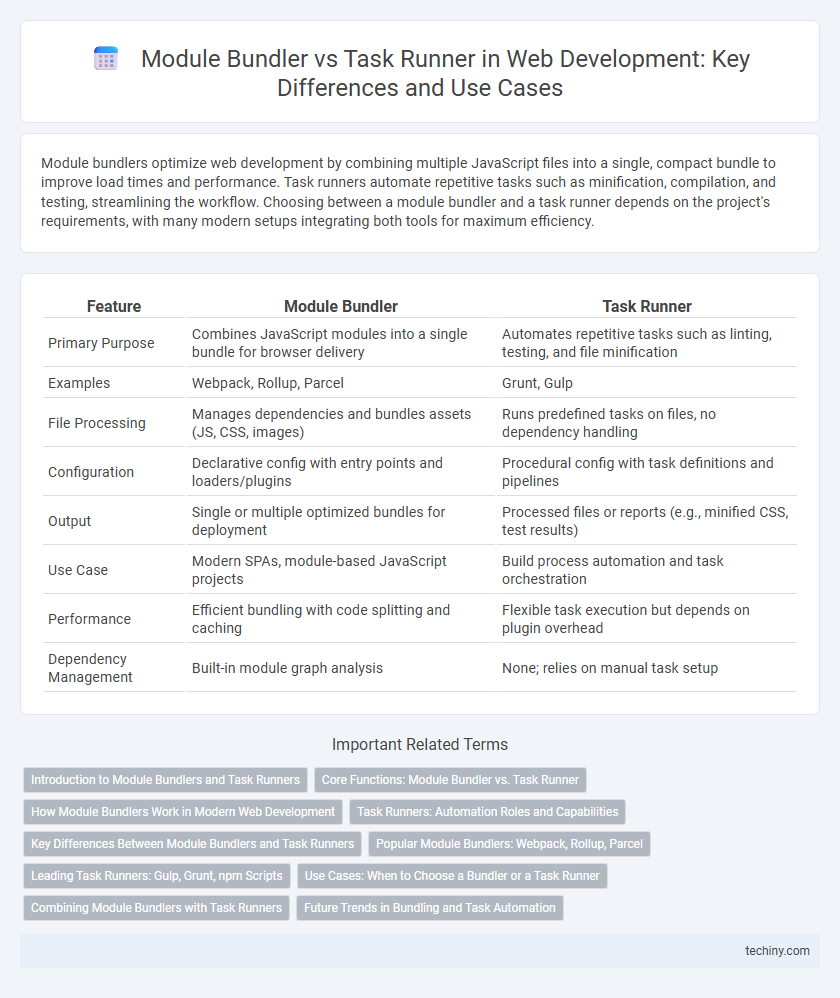Module bundlers optimize web development by combining multiple JavaScript files into a single, compact bundle to improve load times and performance. Task runners automate repetitive tasks such as minification, compilation, and testing, streamlining the workflow. Choosing between a module bundler and a task runner depends on the project's requirements, with many modern setups integrating both tools for maximum efficiency.
Table of Comparison
| Feature | Module Bundler | Task Runner |
|---|---|---|
| Primary Purpose | Combines JavaScript modules into a single bundle for browser delivery | Automates repetitive tasks such as linting, testing, and file minification |
| Examples | Webpack, Rollup, Parcel | Grunt, Gulp |
| File Processing | Manages dependencies and bundles assets (JS, CSS, images) | Runs predefined tasks on files, no dependency handling |
| Configuration | Declarative config with entry points and loaders/plugins | Procedural config with task definitions and pipelines |
| Output | Single or multiple optimized bundles for deployment | Processed files or reports (e.g., minified CSS, test results) |
| Use Case | Modern SPAs, module-based JavaScript projects | Build process automation and task orchestration |
| Performance | Efficient bundling with code splitting and caching | Flexible task execution but depends on plugin overhead |
| Dependency Management | Built-in module graph analysis | None; relies on manual task setup |
Introduction to Module Bundlers and Task Runners
Module bundlers like Webpack and Rollup compile JavaScript files along with dependencies into a single bundle to optimize loading and performance. Task runners such as Gulp and Grunt automate repetitive tasks including minification, compilation, and testing during development workflows. Both tools enhance front-end development efficiency but serve distinct purposes: bundlers focus on module dependency management, while task runners streamline various build processes.
Core Functions: Module Bundler vs. Task Runner
Module bundlers such as Webpack and Rollup primarily focus on compiling JavaScript modules into a single or few optimized files to enhance load performance and manage dependencies. Task runners like Gulp and Grunt specialize in automating repetitive workflows such as minification, linting, and testing to streamline the development process. While module bundlers optimize code delivery, task runners efficiently handle build tasks and asset management, making them complementary tools in modern web development.
How Module Bundlers Work in Modern Web Development
Module bundlers in modern web development analyze and compile multiple JavaScript modules into a single, optimized bundle, improving load times and dependency management. They use static analysis to construct a dependency graph, enabling features like code splitting and tree shaking for efficient asset delivery. Popular bundlers such as Webpack, Rollup, and Parcel automate this process, streamlining development workflows and enhancing application performance.
Task Runners: Automation Roles and Capabilities
Task runners automate repetitive development tasks such as minification, compilation, unit testing, and linting, boosting workflow efficiency. Popular task runners like Gulp and Grunt use configuration files to define and execute sequences of tasks, streamlining build processes and ensuring consistency. Their role extends beyond simple automation by enabling customization and integration with various plugins to tailor front-end and back-end development pipelines.
Key Differences Between Module Bundlers and Task Runners
Module bundlers like Webpack and Rollup focus on packaging JavaScript modules into optimized bundles for efficient browser delivery, handling dependencies and code splitting. Task runners such as Gulp and Grunt automate repetitive development tasks including minification, compilation, and linting to streamline the build process. While module bundlers optimize and manage assets for deployment, task runners orchestrate workflows by running tasks in sequence or parallel based on project needs.
Popular Module Bundlers: Webpack, Rollup, Parcel
Webpack, Rollup, and Parcel are popular module bundlers in web development, designed to efficiently compile JavaScript modules into optimized bundles for faster load times. Webpack offers extensive customization and supports complex dependency graphs, making it suitable for large-scale applications. Rollup focuses on creating small, efficient bundles by leveraging ES modules, while Parcel provides zero-configuration setup and rapid bundling for simpler projects.
Leading Task Runners: Gulp, Grunt, npm Scripts
Leading task runners like Gulp, Grunt, and npm Scripts streamline web development by automating repetitive tasks such as minification, compilation, and testing, enhancing project efficiency. Gulp uses a code-over-configuration approach with streams for fast build pipelines, while Grunt relies on configuration files for task management, offering extensive plugin support. npm Scripts leverage the native Node.js package manager to run scripts directly, providing simplicity and flexibility without additional dependencies.
Use Cases: When to Choose a Bundler or a Task Runner
Module bundlers like Webpack excel in managing dependencies and optimizing assets for deployment, making them ideal for complex JavaScript applications with multiple modules. Task runners such as Gulp or Grunt specialize in automating repetitive development tasks like minification, compilation, and linting, which is crucial for streamlining build processes and enhancing workflow efficiency. Choosing between a bundler and a task runner depends on project requirements: use bundlers for module dependency resolution and code splitting, and task runners for orchestrating diverse build tasks and file transformations.
Combining Module Bundlers with Task Runners
Combining module bundlers like Webpack with task runners such as Gulp enhances web development workflows by automating tasks like file transformations, optimization, and live reloading while efficiently managing dependencies and code splitting. This integration streamlines asset management, reduces build times, and improves maintainability in large-scale projects by leveraging the strengths of both tools. Developers achieve faster development cycles and optimized production builds by synchronizing bundling processes with task automation.
Future Trends in Bundling and Task Automation
Future trends in web development emphasize the convergence of module bundlers and task runners into unified tools that streamline code optimization, asset management, and automation workflows. Advances in bundling prioritize faster build times, intelligent caching, and support for emerging JavaScript features like ES Modules and dynamic imports. Automation tools increasingly integrate AI-driven capabilities for error detection, code splitting, and environment-specific optimizations, enhancing developer productivity and application performance.
module bundler vs task runner Infographic

 techiny.com
techiny.com